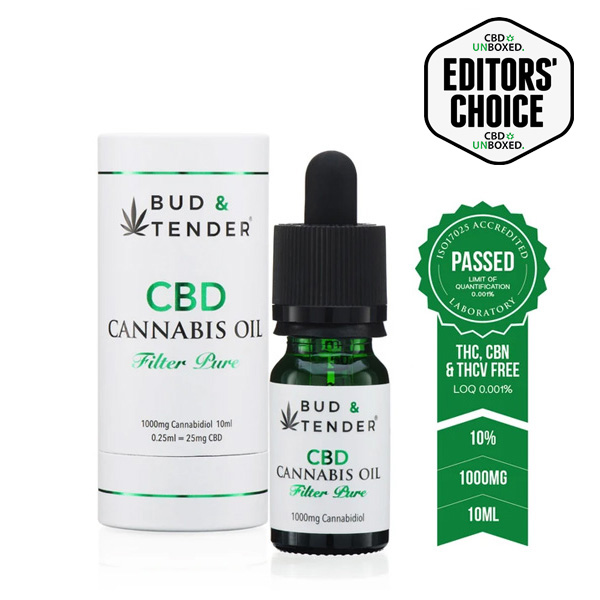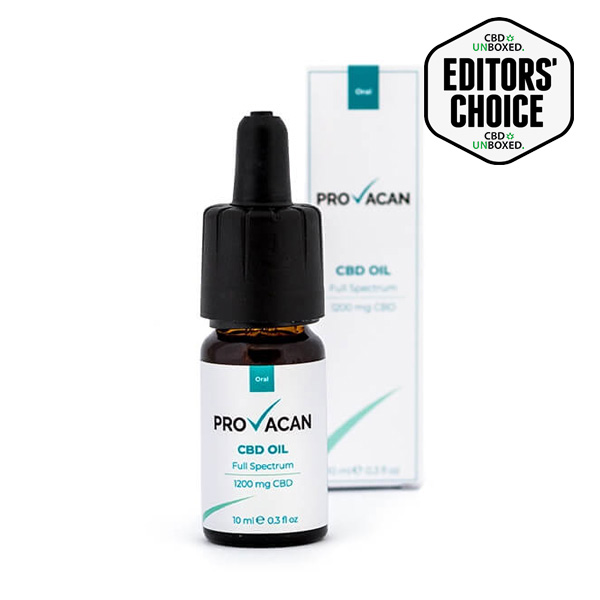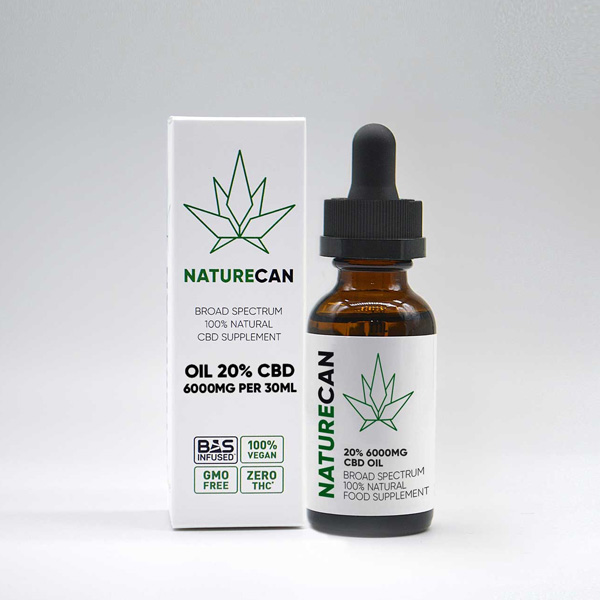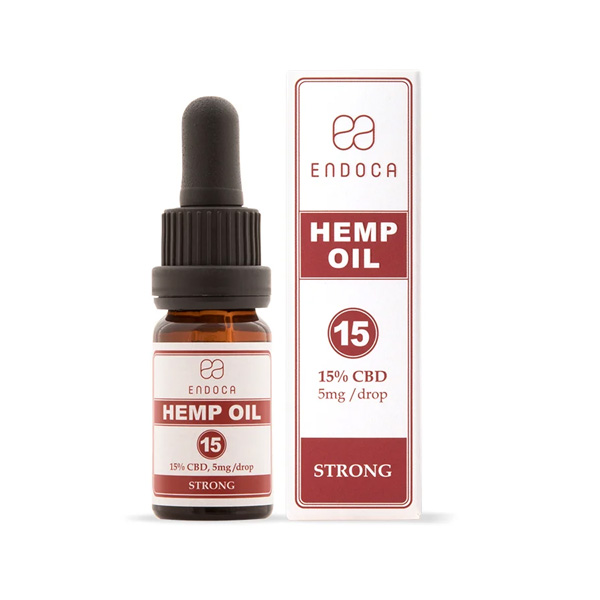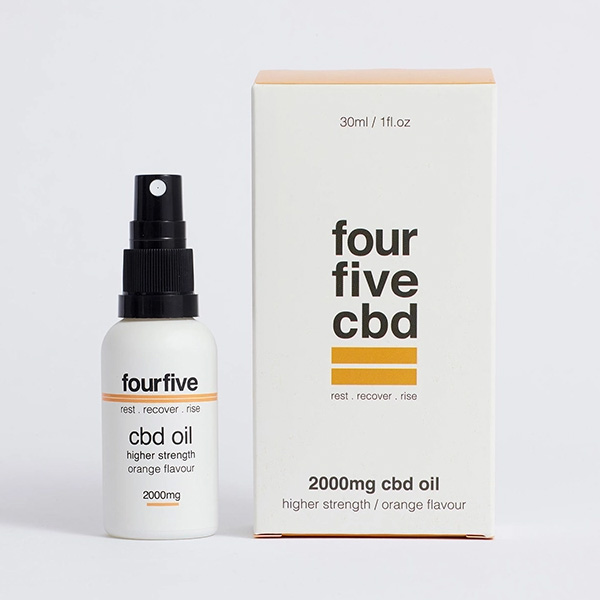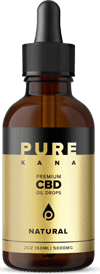New to CBD and suffering from arthritis? We’ve put together this ultimate guide to CBD to help you understand what arthritis is and how CBD’s antiarthritic and pain relief properties can help. We also list the Best CBD Oils for Arthritis at the end of this article.
CBD for Arthritis – The Ultimate Guide
According to the NHS, arthritis is a debilitating disease that affects more than 10 million people in the UK at any given time.
There are several types of this painful condition – osteoarthritis and rheumatoid arthritis being the main ones – that can affect people of all ages and genders, including children. In addition, people who experience traumatic bone injuries can suffer from arthritis at any point following the incident.
Whilst most of us will experience pain and discomfort occasionally or on a recurring basis, chronic arthritis is a degenerative disease, meaning that it tends to deteriorate and get more painful over time. As such, it can be quite a debilitating condition which can also lead to a loss of sleep, increased stressed and even depression.
Choosing CBD, a popular product made from hemp extract (cannabis plant), is a natural way to manage the frequency and intensity of your arthritic episodes, without any of the major side effects of traditional pain medications.
In this article we discuss the benefits of CBD oil for arthritis based on research papers and peer-reviewed studies. We explain how CBD oil can help with arthritis symptoms and provide links to purchase high quality CBD oils we’ve tried and tested.
Take our CBD Quiz
If after reading this guide you are still unsure about what products to choose, simply take our CBD Quiz which has been designed specifically to identify the product and strength that is best suited to your personal needs.
CBD has been proven to have antiarthritic, analgesic (pain relief) as well as anti-inflammatory properties and as such is a great option for people suffering from arthritis.
What is CBD?

Cannabis (or Marijuana) and hemp are the same plant and come from the Cannabaceae family. Both plants are filled with organic compounds known as “cannabinoids”. Hemp has over 112 different cannabinoids, all of which have their own health benefits.
The main two cannabinoids or compounds of the hemp plant are THC (also known as “Tetrahydrocannabinol”) and CBD (also known as “Cannabidiol”).
THC is the compound known to give cannabis smokers this feeling of “high” and is currently illegal in the UK.
CBD on the other hand, contains none of the psychoactive properties associated with THC (meaning it won’t get you “high”) and is completely legal in the UK. It is also non-addictive and has been suggested to have several medical benefits. Some of these benefits include reducing anxiety and depression, improving sleep and insomnia, reducing pain and inflammation, as well as helping with stress or neurological disorders.
These benefits are possible because CBD interacts with your “Endocannabinoid System” (ECS), which essentially monitors and regulate key functions of your body such as your heat level, your food intake, your hormone levels and so on. When your ECS detects that something is operating outside of what it considers to be its “normal range”, it activates to bring things back to its baseline. If you are exercising and become too hot, your ECS activates and makes you sweat to bring your temperature down. If you need more calories for your body to keep performing (for example running) but you aren’t feeding it, your ECS may start redirecting the energy available towards vital organs such as the heart and brain, leading to a drop in physical performance.
The term Endocannabinoid can be broken down into two parts:
- Cannabinoid: which comes from Cannabis
- Endo: which is short for “Endogenous” and means that it is naturally produced by your body.
So endocannabinoid simply means that your body naturally produces cannabinoids, and does so thanks to cannabinoid receptors present in the body, which fall under two categories:
CB1 Receptors

CB1 receptors, which are located in various regions of the body, with a large concentration in the brain and the nerves of the spinal cord, co-ordinate mood, emotion, appetite, and other functions.
CB2 Receptors

CB2 receptors are more commonly found in the immune system and are responsible for controlling inflammation and pain. CBD stimulates these receptors and induces the body to release serotonin.
Serotonin, or 5-HT, is a neurotransmitter that carries signals from one neuron to the other. CBD increases the level of serotonin, which, in return, helps reduce pain, reduce inflammation in the body and possibly reduces the cramping experienced during period pain.
Whilst there are very few differences between “Marijuana” and “Hemp”, the main difference is simply legal and linked to the level of THC that is present in the plant. So different parts of the cannabis plant are either defined as hemp or as cannabis / marijuana.
- Hemp: hemp is the stalks, stems and sterilized seeds of cannabis sativa (“Cannabis Sativa” is the scientific Latin term that defines hemp, cannabis or marijuana plant species)
- Cannabis and Marijuana: the leaves, flowers and viable seeds of cannabis sativa
The varieties of cannabis that are regulated, legal and available in the UK are those that produce less than 0.2 percent THC. And given the fact that most THC is in the flowers, CBD products are primarily made from hemp (stalks, stems and sterilized seeds of cannabis sativa) which contain very little THC and are safe to consume.
There has been a lot of interest in CBD from both the research and medical community over the last few years, due to its range of health applications – including but not limited to pain relief, fighting the side effects of cancer medications, alleviating insomnia, lowering stress levels, improving acne outbreaks, counteracting heat disease, or reducing seizures in patients with epilepsy
For all these reasons, CBD products are legal in the UK if they contain less than 0.2% THC and as long as they are advertised as a health supplement and not a medication.
Products containing CBD come in many different forms, with the most common including CBD oils, CBD gummies, CBD capsules, CBD vapes and CBD edibles. Some forms are more fast-acting than others, some have different flavours, some contain differing proportions of CBD extract, and so on, so the type you choose depends entirely upon your personal preferences and the condition you wish to treat.
Here’s what you need to know about using CBD for arthritis.
Arthritis: What You Need to Know
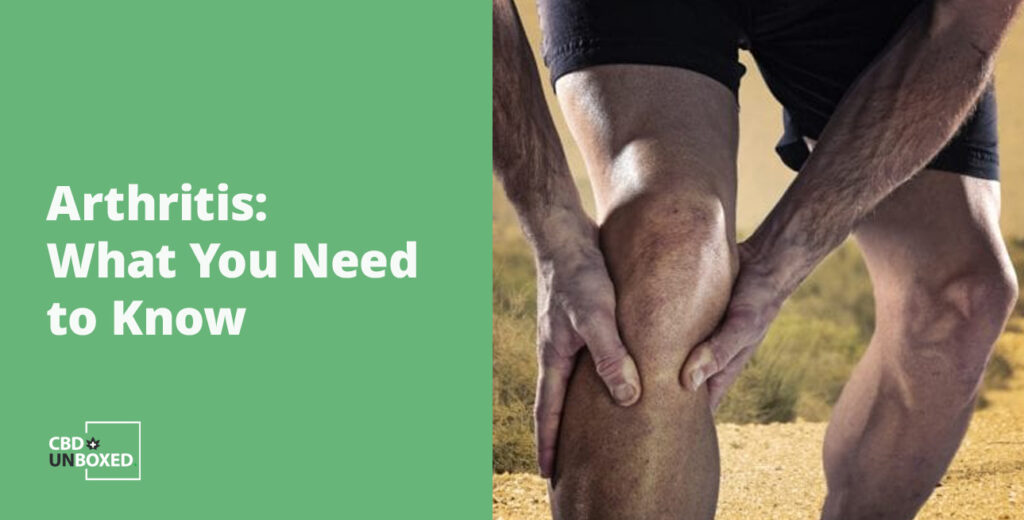
Arthritis can affect any joint in the body. The most common areas affected are the lumbar spine, neck, hip, knees, fingers, and toes.
There are more than 100 arthritic conditions, but two types in particular account for 95% of all cases:
Osteoarthritis
Also known as OA, it occurs from changes in the joints when the cartilage that prevents the bones from connecting begins to wear down. It’s a slow process that starts in the mid-40s and can cause pain, stiffness, swelling, and reduced flexibility.
OA often reduces people’s ability to complete everyday tasks, such as buttoning shirts, washing hair, and cooking. In the UK, nearly 9 million people suffer from OA. According to the Bupa, almost 9 million people in the UK suffer from osteoarthritis, making it the most common type of arthritis by far.
To put this in perspective, Arthritis Research UK published a study highlighting the most common types of OA:
- Knee Osteoarthritis: Affecting 18.2% of adults over 45 years old (England)
- Hip Osteoarthritis: Affceting 10.9% of adults over 45 years old (England)
OA is simply the result of normal day-to-day life and wear and tear of protective cartilage in your body. As you use various parts of your body to walk, run, jump, grab things, stand up and so on, your joints are exposed to a constant level of tiny damages. Whilst the body has powerful self-healing properties and can in most cases repair the damage itself, patients who suffer from osteoarthritis do not benefit from the same self-healing process. The protective cartilage at the ends of their bones (fingers, feet, hip etc) start breaking down, resulting in pain, swelling and reduce mobility of the joint. Over time, bone can grow in that area which becomes inflamed and swollen, resulting in more pain and a shorter range of movement.
Despite decades of research, the causes of OA are still unknown for the most part. However, several factors could increase your risk of developing osteoarthritis, including:
- Obesity – The increase in the prevalence of OA in the UK is directly attributable to the rise in obesity. Since being heavier will put additional pressure on your joints (e.g. hip, knees, ankle, feet), this makes obese people more likely to develop OA. People who are overweight or obese are 2.5 to 4.5 times more likely to develop knee osteoarthritis than those of normal body weight. For patients who already have OA, carrying extra bodyweight can mean a faster destruction of the remaining cartilage and a more painful condition.
- Your Gender – Women are more likely to suffer from OA than men, with women accounting for 60% of hip and knee replacement operations in the UK.
- Pervious Joint Injuries – People who suffered from joint injuries or who have not recovered fully following a joint injury or operation will be at higher risks of developing OA
- Your Age – your risk of developing osteoarthritis increases as you get older. 30% of women and 25% of men between 45-64 have sought treatment for osteoarthritis, this rises to 50% of people aged 75 and over.
Rheumatoid Arthritis
Also known as RA, rheumatoid arthritis is an autoimmune disease. It happens when the body’s immune system attacks the joint capsule lining, which causes swelling and pain. An estimated 1% of the population in the UK are diagnosed with RA. That’s almost 500,000 people. It can also cause additional symptoms other than pain, stiffness, swelling, and loss of range of motion, such as fever, fatigue, weakness, and tenderness.
Rheumatoid arthritis does not affect everyone the same way.
- More prevalent in women: According to a UK study from 2013, the population minimum prevalence of RA is 1.16% in women and 0.44% in men, meaning that women are 2 to 4 times more likely to get RA than men.
- A rare condition: It remains a rare condition in the UK, with around 1.5 men and 3.6 women developing RA per 10,000 people each year.
- 30-50 years old: Whilst RA can affect people of all ages, it would appear as though the peak age of onset in the UK is between 30-50 years old.
RA is the result of an interaction between both genetic and environmental factors, including high birth weight, smoking, exposure to silica, alcohol abstention (as it has been suggested that alcohol consumption can reduce the severeity of the symptoms of RA), obesity, diabetes mellitus, rheumatoid factor, and anti-citrullinated protein antibody.
As with everything, prevention is key and studies have suggested that suppression of inflammation in the early stages of the disease can result in substantial improvements in long-term outcomes. In that respect, CBD could prove useful no tonly to manage the pain once RA is present, but also to reduce the inflammation when RA starts.
Other Arthritic Conditions
However, whilst osteoarthritis and rheumatoid arthritis are the most common types of this disease, a number of other conditions fall under this category:
Fibromyalgia – also known as FMS (Fibromyalgia Syndrome), it is a long-term condition that causes widespread pain in the body and which can also be accompanied by other sumptoms such as muscle stiffness, tiredness, increased sensitivity to pain or difficulty sleeping.
Ankylosing spondylitis – also known as AS, it is a long-term inflammatory condition that primarily affects the bones, muscles and ligaments the spine, resulting in joints fusing together and overall stifness of the spine. AS tends to affect men more than women and to first develop in teenagers and young adults.
Cervical spondylosis – also known as degenerative osteoarthritis, cervical spondylitis is a general term for age-related wear and tear affecting the spinal disks in your neck, leading to pain and stiffness.
Lupus – is an autoimmune condition and long term condition that can affect many different organs and the body’s tissues, causing joint pain, skin rashes and tiredness.
Gout – is a type of arthritis caused by too much uric acid – a waste byproduct formed when your body breaks down purines, which are found in some foods – in the body. This uric acid can be left in joints (usually affecting the big toe but it can develop in any joint) and causes intense pain, redness and swelling.
Psoriatic arthritis – an inflammatory joint condition that can affect people with psoriasis
Enteropathic arthritis – a form of chronic inflammatory arthritis associated with inflammatory bowel disease (IBD), the 2 main types being ulcerative colitis and Crohn’s disease. About 1 in 5 people with Crohn’s disease or ulcerative colitis will develop enteropathic arthritis. The most common areas affected by inflammation are the peripheral (limb) joints and the spine
Reactive arthritis – this can cause inflammation of the joints, eyes and the tube that urine passes through (urethra). It develops shortly after an infection of the bowel, genital tract or, less frequently, after a throat infection.
Secondary arthritis – a type of arthritis that can develop after a joint injury and sometimes occurs many years afterwards.
Polymyalgia rheumatica – a condition that almost always affects people over 50 years of age, where the immune system causes muscle pain and stiffness, usually across the shoulders and tops of the legs. It can also cause joint inflammation.
Side Effects of Arthritis Medication
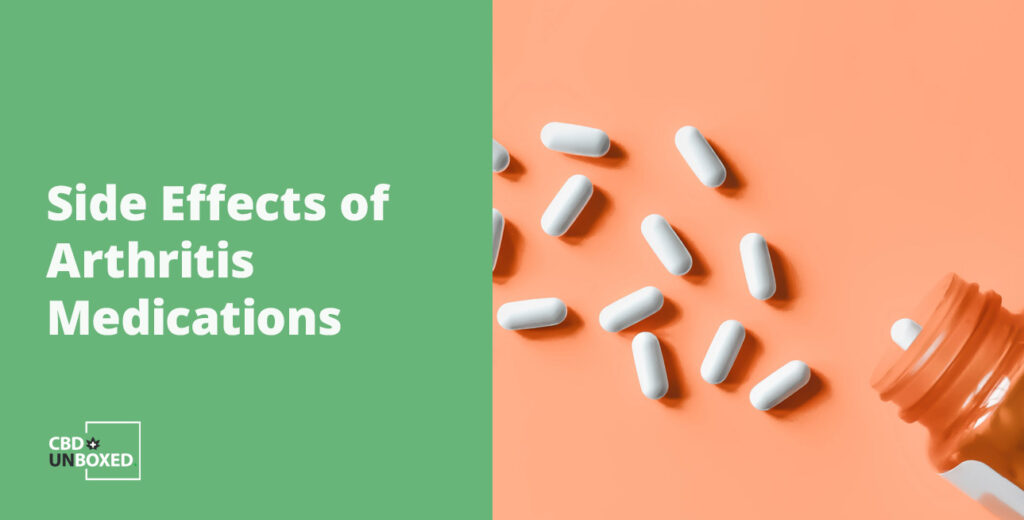
Apart from surgery – joint repair, joint replacement or joint fusion – there are hundreds of medications and treatments available to treat the root cause and the symptoms of arthritis, with the main focus being on relieving symptoms such as pain, inflammation, or muscle stiffness as well as improving overall joint function.
Arthritis Medication
The medications used depend on the type of arthritis but will usually fall under the below categories:
- Painkillers – Painkillers such as Tylenol typically aim to temporarily reduce the pain experienced by the patient but have no effect on the inflammation. They also tend to be limited to patients with mild pain as they are limited in strength. These can be bought over the counter.
- Nonsteroidal anti-inflammatory drugs – Also known as NSAIDs, they target both the pain and the inflammation. Over-the-counter NSAIDs include ibuprofen and naproxen, but be aware that some types of NSAIDs are only available with a prescription from your GP.
- Opioids – Patients suffering from more severe arthritis might get their GP to prescribe opioids such as tramadol, oxycodone or hydrocodone. Whilst opioids act on the central nervous system to relieve pain they also have a number of side effects and can cause mental or physical dependence. You will need a prescription from our GP to get opioids.
- Creams – Some varieties of creams and ointments can be characterized as counterirritants as they contain menthol or capsaicin. Rubbing these preparations on the skin may help relievethe pain by interfering with the transmission of pain signals from the joint itself.
- Disease-modifying antirheumatic drugs – Also known as DMARDs, they are often used to treat rheumatoid arthritis, DMARDs slow or stop your immune system from attacking your joints. Examples include methotrexate (Trexall, Rasuvo, others) and hydroxychloroquine (Plaquenil).
- Corticosteroids – This class of drugs, which includes Cortisone and Prednisone aims to reduce inflammation and suppress the immune system.
Side Effects of Arthritis Medication
Whilst these medications can help with the symptoms of arthritis, they are often associated with side effects and cannot be taken for long periods of time.
- Drugs like Methotrexate, a common medication for patients suffering from Rheumatoid Arthritis (22% of patients with RA) may cause very serious and life threatening side effects as it is a chemotherapy agent and immune-system supressant.
- Oral NSAIDs can cause stomach irritation and may increase the risk of heart attack or stroke and due to their nature, they can become habit-forming, causing mental or physical dependence.
- Aspirin and ibuprofen are not recommended for people who have stomach ulcers, liver or kidney problems.
- Taking any form of painkiller frequently can make headaches worse. It has been reported that almost 75% of chronic migraine sufferers over use headache medications. This is known as painkiller headache or medication overuse headache (MOH).
- In some cases, arthritis medication can cause other side effect such as vision problems, numbness or tingling in the body and extremities, shortness of breath, serious infections and even heart failure.
CBD for Arthritis and Pain
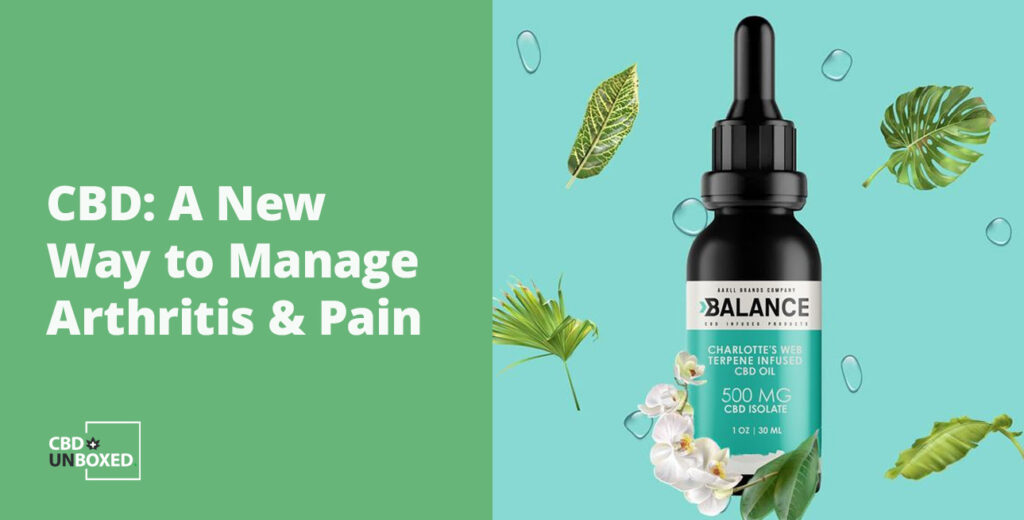
Although people have been using herbal remedies for sleep, anxiety, or pain for centuries, it wasn’t until the last few years that hemp’s legal status changed to allow more users and additional studies.
Cannabidiol, the scientific name for CBD, on the other hand is a naturally occurring compound coming from the hemp plant that helps people fight inflammation, pain and various health related issues.
There is extensive research on the effectiveness of CBD oil when used to treat arthritis, pain and inflammation since CBD has broad therapeutic properties.
Since no cure has yet to be found to treat arthritis, it is important to not only manage the pain experienced, other symptoms as well the impact it may have on your day-to-day life such as lack of sleep, increased stress, anxiety and depression.
When it comes to acute or chronic pain, the main properties of CBD include:
- Antiarthritic: CBD relieves arthritic symptoms
- Analgesic & anti-inflammatory: CBD relieves pain and reduces inflammation in the body (swelling, redness and pain)
- Antidepressant: to fight anxiety and depression
- Sleep: CBD helps with both falling asleep and staying asleep
CBD Has Antiarthritic Properties

CBD is known to have great antiarthritic properties, meaning that it helps relieve or prevent arthritic symptoms.
The two most common types of arthritis are:
Rheumatoid arthritis is an autoimmune condition wherein a person’s immune system attacks their joints, causing inflammation. It commonly affects the hands and feet and leads to painful, swollen, and stiff joints.
Osteoarthritis is a degenerative condition that affects joint cartilage and bones, causing pain and stiffness. It often affects the hip, knee, and thumb joints.
According to a poll conducted by the Arthritis Foundation, 29% of 2,600 patients with either osteoarthritis (52%) or rheumatoid arthritis (45%) for 10 or more years, stated using CBD in liquid or topical form to manage their arthritis symptoms, especially pain.
Of those using CBD, most reported improvement in physical function, sleep, and well-being:
- 67% reported improvement in their physical function
- Over 30% said it provided relief from morning stiffness and helped them to get moving
- 71% reported improvements in their ability to sleep
- Over 30% said it helped relieve symptoms of fatigue
But CBD also helped those suffering from arthritis improve their overall well-being, with people who used CBD reporting emotional and mental health benefits, in addition to relief of physical pain.
- 41% reported a better overall sense of well-being
- 77% reported a lower level of anxiety
- 67% reported effectiveness in improving depressed mood
From a research standpoint, while there are various studies suggesting CBD might be a promising approach, and animal studies showing anti-inflammatory and pain-relieving effects, well-designed studies demonstrating compelling evidence that CBD is effective for chronic arthritis pain in humans do not yet exist.
CBD Relieves Arthritic Pain

CBD has strong analgesic properties, meaning that it helps relieve pain. But how?
The human body contains a specialized system called the ECS (the endocannabinoid system), which aims to regulate a variety of functions such as sleep, appetite, pain and immune system response. The body also produces endocannabinoids, which are simply neurotransmitters that bind to cannabinoid receptors in your nervous system.
CBD is believed to interact with specific receptors, specifically the CB1R and CB2R.
- CB1 receptors, which are located in various regions of the body, with a large concentration in the central nervous system and brain, co-ordinate mood, emotion, appetite, and other functions.
- CB2 receptors are more commonly found in the immune system and are responsible for controlling inflammation and pain. CBD stimulates these receptors and induces the body to release serotonin.
Additionally, CBD increases the level of serotonin, or 5-HT, a neurotransmitter that carries signals from one neuron to the other. By doing so, it helps reduce pain and inflammation in the body.
According to Researchgate, a study published in November 2019 shows improvement of physical discomforts such as headaches and various signs of physical pain. According to Teitelbaum J, there have been multiple studies showing patients found relief of menstrual pain, back pain, spinal pain, joint pain (e.g. arthritis) or fibromyalgia pain.
Furthermore, a 2018 review of the relevant research also reports that cannabis seems promising as a method of relieving pain, including pain from headache.
CBD Can Reduce Anxiety & Depression

Many studies link arthritis and depression. In fact, people with arthritis are up to three times more likely to have depression than someone without arthritis.
When it comes to depression and anxiety-related disorders, it is important to understand the crucial role brain chemistry plays, especially in relation to the hippocampus and the amygdala.
- Hippocampus: The hippocampus is a complex part of the brain that plays a major role in cognitive and emotional functions. There is increasing evidence showing that adult hippocampal neurogenesis – the process by which the hippocampus regenerates thanks to neural stem cells producing new neurons – helps reduce stress and anxiety by boosting the endocrine response. Put it simply, people with attenuated (reduced) hippocampal neurogenesis are more likely to develop anxiety-related behaviours.
- Amygdala: The amygdala is a collection of cells near the base of the brain (there is one in each side of the brain) that is part of the brain’s limbic system. It is the area of the brain where emotions are given meaning and remembered. Research has shown that people who suffer from depression will experience a hyper-active amygdala.
CBD helps to ease the symptoms of depression by regulating the functions of the hippocampus and the amygdala, and therefore their effects on how our brain processes potentially anxiety ridden information or situations.
How does CBD help?
CBD has been proven to increase cerebral blood flow to areas of the brain associated with memory processing, specifically the hippocampus. The findings identify a potential mechanism for the use of CBD to treat disorders associated with altered memory processing, including Alzheimer’s disease, PTSD, and schizophrenia.
Put it simply, a single dose of cannabidiol (CBD) helped increase blood flow to the hippocampus, an important area of the brain associated with memory and emotion, which means that CBD has been proven by several scientists and medical professionals to help smooth the cognitive processes of this part of the brain.
According to Dr Michael Bloomfield from UCL: “Cannabidiol is one of the main constituents of cannabis and is gaining interest for its therapeutic potential. There is evidence that CBD may help reduce symptoms of psychosis and anxiety as well as improve memory function. Additionally, CBD changes how the brain processes emotional memories, which could help to explain its reputed therapeutic effects in PTSD and other psychiatric disorders.”
These finding have been backed by double blind studies where on different occasions, separated by at least a week, each participant was given a 600mg of oral CBD or a placebo. The doses came in identical capsules, so participants did not know which one they were taking on which occasion.

Researchers measured blood flow to the hippocampus using ‘arterial spin labelling’ – an MRI (magnetic resonance imaging) brain scanning technique which measures changes in the blood oxygen levels.
CBD significantly increased blood flow in the hippocampus, however CBD did not cause significant differences in blood flow in other regions of the medial temporal lobe (MTL), of which the hippocampus is a significant component.
In the prefrontal cortex, the area of the brain used for planning and decision making, CBD caused a significant increase in blood flow in the orbitofrontal cortex.
This supports the view that CBD has region-specific blood flow effects in the human brain, which would help with conditions such as depression, stress and anxiety.
In a double-blind study in Brazil, 57 participants received either CBD oil or a placebo 90 minutes before they underwent a simulated public speaking event. The researchers found that a 300-mg dose of CBD was the most effective at significantly reducing anxiety during the event.
Since one of the buy-products of CBD consumption is an increased blood flow in the hippocampus as well as in the orbitofrontal cortex, researchers assume that CBD essentially helps repair damage in both these areas caused by the symptoms of depression and anxiety.
And seeing as sleep deprivation is largely related to depression and anxiety issues; it’s good to know that CBD also has well known benefits when it comes to insomnia also.
CBD Can Improve Your Sleep

Most people suffering from arthritis will be in pain throughout the day and may even struggle to sleep at night. So how can CBD help?
There is extensive research on the effectiveness of CBD oil to treat insomnia and improve sleep.
CBD works with the human body to increase calm, decrease stress, and lower anxiety levels. These responses indirectly improve your sleep. In the 1990s, researchers confirmed the body has an endocannabinoid system or ECS. Researchers have only found a link between the cannabinoids found in hemp with the ECS, making it an unusual reaction.
The ECS is a complex cell-signalling system consisting of endocannabinoids, cannabinoid receptors, and enzymes. Scientists believe it plays many roles, including maintaining balance in the body. When it comes to sleep, the ECS helps regulate sleep and sleep cycles. Also, relating to sleep, a potential function is boosting anandamide to reduce depression and anxiety.
The cannabinoid receptors interact with endocannabinoids and cannabinoids. The CB1 is located in the nervous system and brain. Additionally, the CB2 is found mostly in the immune system and most organs.
A recent surge in scientific publications has found preclinical and clinical evidence documenting value for CBD in some neuropsychiatric disorders, including epilepsy, anxiety, and schizophrenia. Evidence points toward a calming effect for CBD in the central nervous system.
In 2019, a large case series was published in the Permanente Journal about CBD’s calming effects on the central nervous system. The studies showed patients taking CBD saw lower anxiety levels, experienced less stress, and slept better at night. Additionally, most participants experienced no or few side effects.
So through its pain relief and calming effect, CBD may help people fall asleep faster and stay asleep throughout the night.
CBD: The ‘Entourage Effect’

Now that you know how CBD can help you manage your arthritis and pain, it is important to understand the concept of ‘entourage effect’.
The entourage effect is the theory that while each botanical compound has a unique role or benefit, its behaviour may change when the presence of another compound is present.
For example, it would be more effective and quicker to produce a play with a team of actors rather than one actor playing all the parts. When each actor has a specific role to focus on, they can learn their lines and direction and support their fellow actors. But one actor alone will take a lot longer to learn all the lines for the various parts they have to play.
This is similar to the entourage effect. Essentially, everyone knows their role, but their performance can be enhanced by comradery.
But how is this applied to CBD?
CBD Entourage
We know that CBD products stimulate the endocannabinoid system and make it work more efficiently. But different CBD products affect the ECS differently, depending on their formulation. As previously, discussed there are 3 types of CBD formulation:
- Full-spectrum: No additional extraction, contains all the natural ingredients of the hemp plant, including CBD, THC, terpenes and flavonoids.
- Broad-spectrum: All traces of THC are removed from the oil. Every other ingredient remains.
- CBD Isolate: The oil only contains CBD, everything else is removed.
One of the above formulations has been proven to give better results in reducing pain, inflammation and many other symptoms. Which one of these formulations do you think stimulates the ECS best?
Would it be the most natural substance (full-spectrum), the one with any psychoactive ingredients (broad-spectrum) or the purest form of CBD (isolate)?
According to the entourage effect, it is the full-spectrum CBD because it keeps all the natural components of the hemp plant, which include:
Cannabinoids and Terpenes
The theory of the entourage effect was first introduced by Dr Ethan B. Russo. He thinks that cannabinoids such as CBD and THC work with terpenes (aromatic component) to produce a “synergy.”
In his study “Taming THC: Potential cannabis synergy and phytocannabinoid-terpenoid entourage effects” (2010) Dr Ethan B Russo suggests:
- The terpene pinene, which gives the scent of pine, may help counteract compromised memory caused by THC.
- CBD and terpene limonene, which gives a citrus scent, might work together to alleviate anxiety.
- A combination of CBD and terpene caryophyllene, offering a pepper smell, may be beneficial in the treatment of addiction.
The possibility of “synergy” of endless but have not yet been categorically proven. For more information read his other study “The Case for the Entourage Effect and Conventional Breeding of Clinical Cannabis: No “Strain, No Gain” published in 2019.
Omega-3, Antioxidants and Nutrients
In addition to CBD, THC and terpenes, full-spectrum CBD oil also contains Omega-3, which is vital to the ECS. Omega-3 is used to maintain the receptor CB1, which regulate pain and memory.
It also aids the absorption of external cannabinoids, as well as making endocannabinoids internally.
Other nutrients and antioxidants have also been discovered in full-spectrum CBD oil, for example, Vitamin E. Vitamin E is a fat-soluble compound that can prevent cataract formation, postpone the appearance of wrinkles and grey hair, boosts the immune system and reduces inflammation.
As you can see CBD oil when first extracted from the hemp plant has a huge list of ingredients. All of them seem to play a part in helping our bodies. We may not know exactly what they all do. But as time passes and research continues, we can learn more.
Is CBD Legal in the UK?

CBD oil, like any other natural remedy, has been used throughout the ages for its medicinal properties. It was evidenced to have been used in ancient societies with the first recorded case in 2727 B.C in China. It was used to treat anything from poor memory and malaria to gout. It has since been used throughout the world to treat various ailments from anxiety to insomnia and menstrual pains.
Throughout the 1940s, there was extensive research into isolating the CBD compound from the other 100+ compounds found within the marijuana plant, due to its lack of psychoactive effects.
It wasn’t until the 1970’s when the US legally recognised the medicinal worth of CBD oil, and it was decriminalised in Oregon. There was a large emphasis on the clear distinction between the CBD compound and the THC compound within the marijuana plant.
The UK followed suit in 2016, making it legal to buy CBD oil to help treat a multitude of health issues, including but not limited to:
- Depression and anxiety disorders (PTSD, OCD, panic disorder or substance/addiction disorders)
- Chronic pain and inflammation
- Epilepsy
- Heart issues
- Helps to reduce blood pressure and oxidative stress
- Diabetes
- Fight bacteria
- Insomnia and sleep related issues
- Helps with symptoms of schizophrenia,
- Skin conditions (psoriasis/eczema)
- Alzheimer’s disease
In a study conducted by the Centre for Medical Cannabis, their results showed that one in six adults in the UK had tried CBD oil, proving that it is one of the fastest-growing, contemporary, well-being products on the market.
Figures also show that the rates of people using CBD oil were higher amongst the under 55 age range. Also, figures were higher amongst females, with 62% of them using CBD to treat anxiety related issues.
How to Take CBD for Arthritis?

There are a few ways to take CBD for arthritis and pain relief. Choosing a method is often a personal preference. The most common are tinctures, gummies, capsules, vapes and topicals.
CBD Tinctures

CBD oil is the most common way of getting your daily dose of CBD to help you reduce pain and inflammation.
However, whilst this is the most popular way to consume CBD, CBD oil often has a more earthy, nutty, woody or grass-like taste which is down to the fact the product is natural, safe, and non-toxic.
You can use CBD oil in different manners.
You can either place a few drops under the tongue and hold it there for 30 to 60 seconds. This way of consuming CBD – called sub-lingual. This is one of the best ways to get it absorbed into the bloodstream as this method allows CBD to completely bypass the digestive system and liver metabolism, so the compounds can avoid being broken down by enzymes and reach the bloodstream more quickly. This offers the quickest relief with an onset of 20 minutes or less.
For those who feel the earthy or grassy taste of CBD is too strong, another option is to mix it with a food or a drink to mask the taste. However, be aware that when you digest CBD, it will not provide immediate relief and you may need to wait 30 to 60 minutes for it to start working.
CBD Capsules

If the earthy and grassy taste of CBD oil or its sharp and bitter aftertaste is not for you, you may want to choose CBD capsules to experience all the benefits of CBD without any of the nasty taste or additives that gummies may contain (such as sugar).
CBD capsules are filled with a precise dose of CBD (usually between 10mg and 50mg of CBD per capsule). You can take one or two capsules, once or twice daily with a full glass of water. The CBD usually comes from full-spectrum (<0.01% THC) ground hemp and is rich in cannabinoids and terpenes. However, seeing as CBD capsules go through the digestive system, they take about an hour or so to work.
Choosing capsules is a great way to get your CBD intake and it’s incredibly travel friendly, the ideal solution for those who are always on the go.
CBD Gummies

For consumers who aren’t comfortable using the sublingual drops or those who struggle to swallow capsules, the CBD-infused chewy candies are a yummy way to consume the hemp extract.
Using CBD gummies is also an easy and accurate way of measuring that you are getting the right amount of CBD as each gummy will provide you with an exact dose of CBD (from 10mg to 50mg).
Unlike CBD oil which acts within 20-30 minutes as it gets absorbed into the blood stream, the onset for CBD gummies is about an hour as edibles need to go through the digestive system.
Finally, remember that gummies tend to contain additional ingredients – including sugar and additives. So whilst gummies are a convenient way to get your daily intake of CBD to treat your pain, eating 3-5 gummies each day could have a negative impact on your overall sugar intake! This isn’t always ideal and for that reason, we would always recommend going for CBD oil or CBD capsules whenever possible.
CBD Vapes

Whilst the team at CBD Unboxed isn’t pro-smoking or pro-vaping, using a vape and inhaling CBD appears to be a great way to get your daily dose of CBD as the heating process occurring whilst smoking increases absorption.
How? By smoking CBD, the active compounds quickly enter the bloodstream via the lungs where they are transported throughout the body. Compared to oral intake such as gummies and capsules, vaping avoids the liver breaking down many of CBD’s beneficial compounds which enhances its potency.
Also, unlike edibles which often contain additional ingredients, the only two ingredients present in CBD vapes and vape juices tend to be cannabinoids and terpenes, natural substances commonly found in herbs, fruits, flowers and plants.
Whilst this seems a great way to get your daily CBD intake, we cannot comment on its use or efficacy as we have not tried vaping products and most research papers to this day have focused on CBD oil.
CBD Creams & Balms

Another great way to use CBD to reduce pain and inflammation is by using topical CBD in the form of creams, balms or salves.
Hemp extract creams are applied directly to the sore area. These applications are often combined with other ingredients that help reduce pain, such as turmeric, ginger, and capsaicin.
As CBD creams are for topical use, it can take a while to penetrate and may not provide fast-acting relief. For that reason, it is usually best to combine a topical with a fast acting product such as a CBD oil which will get to work in less than 20 minutes.
For the Ultimate Relief: Mix & Match
An excellent option is to combine the methods. Your CBD tincture, when taken under the tongue, can take up to 30 minutes to fully work. To ease discomfort while waiting, many consumers may use a CBD vape pen which may act faster.
The same advice works for other methods. Your topical CBD cream will take at least 30-60 minutes to provide relief, and gummies and capsules go through the digestion process and have an average onset time of 30 to 90 minutes. By using multiple methods, you may reduce discomfort and pain so you can go about your day.
For the most significant assistance when levels are high, consider applying a topical balm directly to the area that’s bothering you. Follow up with a tincture dose of 15mg to 30mg under your tongue.
How Much CBD Should You Consume?

CBD doesn’t have one-size-fits-all dosing and calculating a proper dosage of CBD can be tough as our bodies react to it differently.
CBD Dosage Table
We would first recommend using the above CBD dosage table to determine how much CBD you should consume on a daily basis.
The four major factors affecting your CBD dosage are:
- Your weight
- The condition being treated (i.e. depression, chronic pain etc)
- The severity of your condition
- The concentration of CBD oil
Most brands recommend customers start with the lowest dose and increase until they find the right serving size that fits their needs. The most common starting amount is between 10mg and 25mg. For anxiety and depression, the dose can vary from 20mg to 50mg or more.
As a rule of thumb, a person weighting between 10.5 and 17 stones (approximately 150 and 240 lbs) may need between 20mg and 40mg of CBD per day depending on the severity of their symptoms.
When using CBD for the first time, we would always recommend starting with one or two drops of the 3% or 6% CBD oil placed under the tongue (sublingual) and holding it there for at least 30 seconds so it can absorb into the bloodstream.
Taking it first thing in the morning on an empty stomach to see how your body reacts to it is also recommended. If you are not seeing any major benefits with a single drop, increase your intake by a single drop every 2 or 3 days until finding the right balance to treat your personal symptoms.
Finally, as CBD remains a novel food, it is worth noting that the Food Standards Agency (FSA) recommends that healthy adults do not take more than 70mg a day, unless advised by a medical professional.
How Many CBD Oil Drops?
Whilst it may be confusing at the beginning, it’s incredibly simple to work out how many drops of CBD oil you need to take depending on your daily requirements and the strength of the product you bought.
Most bottles of CBD oil contain 10ml of product and come in strengths ranging from 300mg to 2,400mg – also known as 3% and 24% CBD oils. This simply means that in a 1ml drop of the 300mg bottle, you will have 30mg of CBD, whilst the same 1ml of the 2,400mg bottle will give you 8 times that amount for a total of 240mg of CBD.
So assuming you need to hit 25mg of CBD per day with, you will need:
| CBD / Bottle* | CBD / Drop | # Drops |
| 500mg | 1.25mg | 20 drops |
| 1000mg | 2.5mg | 10 drops |
| 1800mg | 4.5mg | 5.5 drops |
| 2400mg | 6.0mg | 4 drops |
*Based on 10ml bottles
Assuming you are using the 500mg CBD oil for a daily dose of 25mg, you will need to take approximately 20 drops per day (25mg divided by 1.25mg per drop). You could break this down throughout the day by taking:
- 8 drops first thing in the morning on an empty stomach
- 6 drops early afternoon
- 6 drops at night before going to bed
If however you bought the 2400mg CBD oil for a daily dose of 25mg, you would only need to take 4 drops per day (25mg divided by 6mg per drop), which you could also spread across the day – 2 in the morning, one in the afternoon and one in the evening.
As with everything, start with a small amount of CBD oil daily to make sure there’s no reaction, then increase slowly by a drop every 1-2 days until finding the right balance.
What to Expect When Taking CBD?

First-time users may experience relief immediately, as CBD is brand new to your ECS. However, this does depend on the ailment you are trying to improve. For example, one dose of CBD could relieve pain, reduce anxiety and reduce nausea but it wouldn’t stop seizures, cure your depression or diabetes.
If it took you a long time to get the symptom then the same will be said for reducing, preventing or eliminating it.
Immediate Relief (After 24 hours a noticeable difference is seen):
Pain, Inflammation, Migraines, Nausea, Anxiety, Arthritis, Epilepsy, Glaucoma, Stress, Insomnia, Multiple Sclerosis, PTSD, Rheumatism and Motion Sickness.
Short Term Relief (Noticeable between 2-14 days):
Acne, Inflammation, ADD/ADHD, Anxiety, Arthritis, Epilepsy, Depression, Stress, Insomnia, Multiple Sclerosis, PTSD, Rheumatism, Endocrine Disorders, Obesity, OCD, Spinal Cord Injury and Rheumatism.
Long Term Relief (Noticeable between 2+ weeks):
ALS, Addiction, Alzheimer’s Disease, Asthma, Atherosclerosis, Autism, Bipolar Disorder, Cancer, Inflammatory Bowel Disease, Depression, Diabetes, Endocrine Disorders, Fatty Liver Disease, Fibromyalgia, Heart Disease, Huntington´s Disease, Kidney Disease, Metabolic Syndrome, Mood Disorders, Neurodegeneration, Obesity, Parkinson´s Disease, Prion Disease, Schizophrenia and Traumatic Brain Injury.
As you can see from the above, symptoms which occur quickly can be improved in the same short time frame. Progressive illnesses and their more severe side effects require longer exposure to CBD before a real difference can be seen.
This is just a general guide, and it’s important to note that every single person will react differently to CBD as no one person has the same biology and lifestyle.
What are the Side Effects of CBD?
Most people do not experience any side effects when taking CBD as this is a natural product. However, as with everything, some people may experience mild side-effects from the hemp extract, including:
- Diarrhoea
- Changes in appetite and weight
- Nausea
- Fatigue
- Irritability
- Drowsiness
The best way to decrease adverse reactions is to simply lower your daily intake of CBD, or if taking CBD oil under the tongue, to mix it with your food and drink as it will be processed by the digestive system – which means slower absorption. The downside of mixing it with your food is a decreased bioavailability so CBD may not work as well for you.
How To Choose Quality CBD?

As with anything you ingest, the source and quality of your CBD products are important. We would always recommend looking at five main aspects before choosing your CBD product.
CBD Oil from Organic Hemp
Hemp can be grown in just the same way as any other plant – mass-produced and using pesticides and GMOs for the greatest profit, or grown organically with care and attention to provide a fantastic end product.
The best CBD is produced from organic hemp that has benefited from plenty of rain during the growing process. While hemp can physically be grown in many countries, it grows best when the temperature is in the low twenties Celsius. Therefore, the location of the hemp farm is important to ensure the optimum environmental factors are accommodated.
And seeing as cannabis plants can be stressed out by the weather, resulting in a higher THC content (above 0.2%), it’s important to ensure that your CBD oil comes from organic hemp which has been grown in the right part of the world.
Less Than 0.2% THC
Cannabis flowers and extracts usually contain two cannabinoids known as THC (tetrahydrocannabinol) and CBD (cannabidiol). Yet the exact percentage of each can vary greatly, depending on the plant variety and the growing technique used.
THC is the main psychoactive compound in cannabis that produces the high sensation, while CBD has been associated with health benefits.
The EU common agricultural policy states that cannabis plant can be grown for industrial uses, provided their THC content does not exceed 0.2 %. That’s in the plant, not in the CBD product you buy.
So when buying CBD oil from a shop or online retailer, be sure to check that their products contain less than 0.2% THC.
Clean Extraction Method
Once the hemp is grown and harvested, the CBD needs to be extracted from the plant. There are several methods for doing this, including the use of carbon dioxide (CO2). This produces the cleanest and purest CBD extract but can be expensive to do as the machinery required is not cheap.
Alternative methods include using solvents such as ethanol or plant oils (eg olive oil) to extract the CBD.
This can lead to less-pure CBD extract, as small amounts of solvent or oil can remain, although most companies using this type of extraction method will usually test their CBD extracts to ensure they are solvent free and safe to consume.
Tested by Independent Labs
Another thing we would recommend checking is whether or not your CBD oil has contaminants. That’s because cannabis plants readily absorb heavy metals, pesticides, and other potentially harmful chemicals that may be in the soil or water.
To ensure your CBD oil is free of those harmful chemicals, it should be tested frequently while the hemp is growing, and finished products should also be tested, using validated methods.
The extract should be tested and certified by a third-party laboratory to confirm the quality of the CBD. Organic CBD should be GMO-free, pesticide-free, and as pure as possible. In the UK and EU, CBD must register THC content of 0.2% or lower.
Most reputable companies selling CBD oil in the UK publish their lab results on their website. Below are a few examples of companies that play the transparency card with their customer and share their lab results for each batch of CBD they produce:
- Blessed CBD
- Provacan
- Hempura
- Endoca
- Naturecan CBD
- Medterra
- Love CBD
Strength to Match your Needs
Finally, the CBD level within any product should be of a suitable strength to match your needs. Every person is different and their body will respond in a slightly different way, so the level may partially be down to personal preference.
However, higher concentrations might be more suitable for treating different ailments to lower concentrations, and it is wise to check the level of CBD in every product you use.
As a rule of thumb, people looking to use CBD for sleep, anxiety, digestion, relaxation or stress might take between 10mg and 25mg of CBD daily and use the lowest strength (300mg to 600mg), whilst those using CBD as a pain relief for conditions such as severe arthritis, back pain or migraines may want to take 30mg to 50mg of CBD per day and use higher concentration products (1200mg to 2400mg).
So remember that CBD oil comes in different concentration and that this will impact how many drops you need to take – for example Blessed 500mg CBD oil (5%) contains 1.25mg of CBD per drop, whilst their 1800mg CBD oil (18%) contains 4.5mg of CBD per drop.
Top 5 CBD Oils for Arthritis

With over 150 CBD brands on the market, it can be difficult to choose the right CBD product. This is why the CBD Unboxed team has tried and tested all most CBD products and brands available in the UK market and assessed them across 6 key areas:
- Efficacy
- Taste
- Value for Money
- Third Party Certification
- Packaging and Shipping
- Delivery
Based on our findings and whilst every person will be different, we would recommend the below five CBD oils to start with.
- 10ml bottle (1000mg of CBD)
- 10% concentration
- Approx 2.5mg of CBD per drop
- Broad spectrum CBD
- Zero THC
- Organic MCT carrier oil
- Entourage effect
- 30ml per bottle (3000mg of CBD)
- 10% concentration
- Approx 2.5mg of CBD per drop
- 99%+ Pure CBD (isolate)
- Zero THC
- MCT oil carrier
- 10ml per bottle (1000mg of CBD)
- 10% concentration
- Approx 4mg of CBD per drop
- Full spectrum CBD
- Less than 0.2% THC
- Hemp seed oil carrier
- Entourage effect
- 10ml bottle (1200mg of CBD)
- 12% concentration
- Approx 3mg of CBD per drop
- Full spectrum CBD
- Less than 0.05% THC guaranteed
- Olive oil carrier
- Entourage effect
- 10ml bottle (2000mg of CBD)
- 20% concentration
- Approx 8mg of CBD per drop
- Broad spectrum CBD (THC free)
- Organic MCT carrier oil
- Entourage effect
- Suitable for vegans
- 10ml bottle (1500mg of CBD)
- 15% concentration
- Approx 5mg of CBD per drop
- Full spectrum CBD
- Less than 0.2% THC
- Hemp seed oil carrier
- Entourage effect
- 20ml per bottle (2000mg of CBD)
- 10% concentration
- Approx 16mg of CBD per spray
- Broad spectrum CBD
- Zero THC
- Olive oil carrier
- Entourage effect
- 30ml per bottle (2000mg of CBD)
- Approx. 8.3mg of CBD per spray
- Approx. 240 sprays per bottle
- Broad-spectrum CBD
- Zero THC
- MCT oil carrier
- 10ml per bottle (1000mg of CBD)
- 10% concentration
- Approx 5mg of CBD per drop
- Full spectrum CBD
- Less than 0.02% THC
- Hemp oil carrier
- Entourage effect
Bud & Tender CBD
Bud & Tender CBD Oil 1000mg (10%)
£80.00
Medterra CBD
Medterra CBD Oil 3000mg (10%)
£89.99
Blessed CBD
Blessed CBD Oil 1000mg (10%)
£74.95
Provacan CBD
Provacan CBD Oil 1200mg (12%)
£69.99
Naturecan CBD
Naturecan CBD Oil 2000mg (20%)
£84.99
Endoca CBD
Endoca CBD Oil 1500mg (15%)
£119.00
Love CBD
Love CBD Entourage Oil 2000mg (10%)
£99.99
Four Five CBD
Four Five CBD Oil 2000mg (6%)
£90.00
Hempura CBD
Hempura CBD Oil 1000mg (10%)
£64.99
Take the CBD Quiz
If after reading this guide you are still unsure about what products to choose to help manage your pain and reduce your arthritic symptoms, simply take our CBD Quiz which has been designed specifically to identify the product and strength that is best suited to your personal needs.









